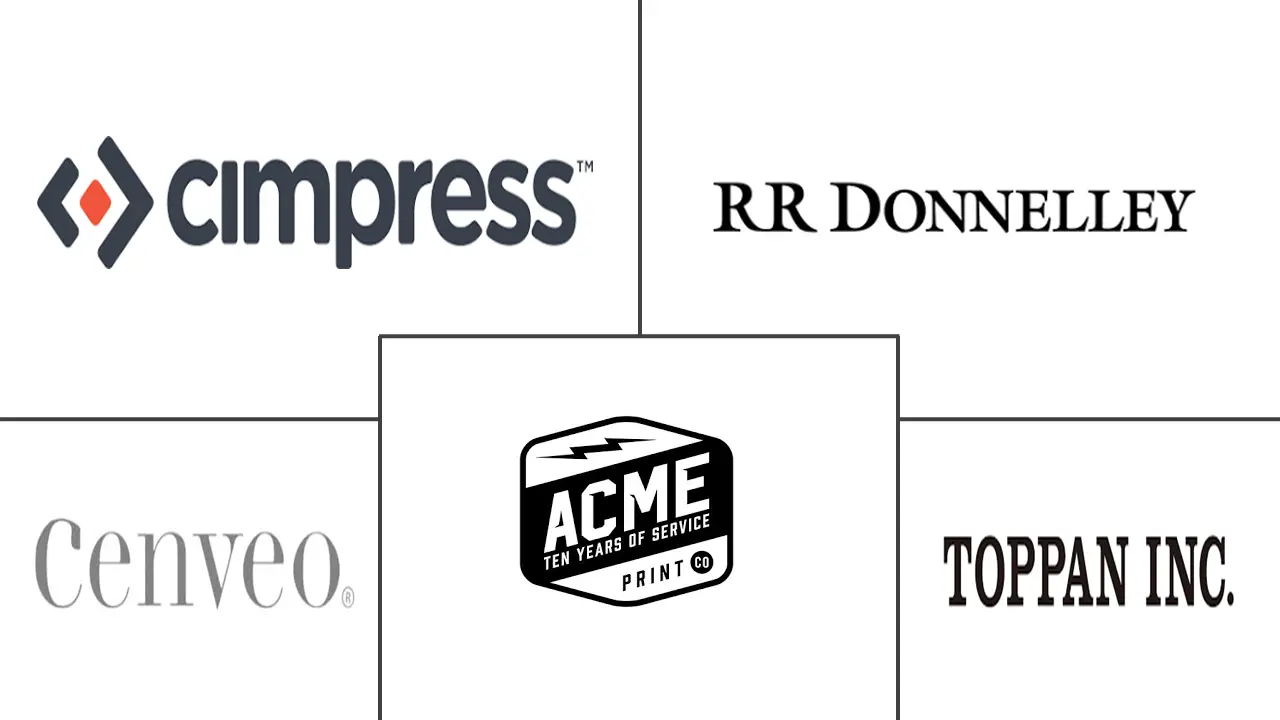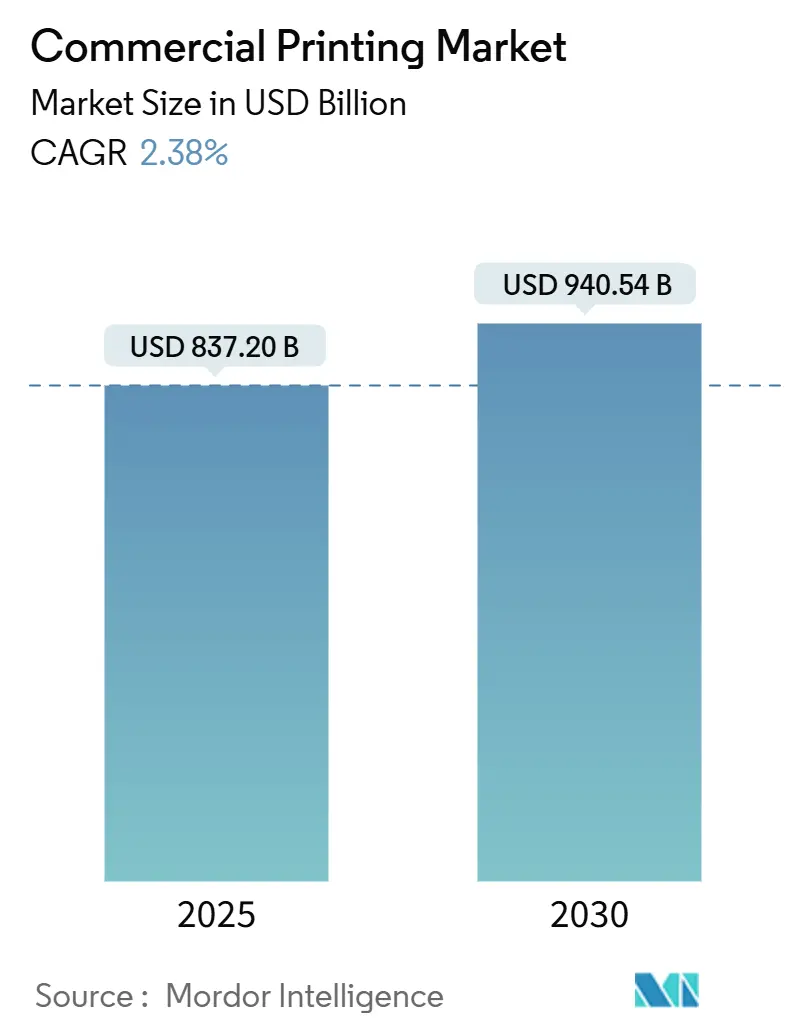
Commercial Printing Market Analysis by Mordor Intelligence
The commercial printing market size is valued at USD 837.20 billion in 2025 and is forecast to reach USD 940.54 billion by 2030, advancing at a 2.38% CAGR. This performance indicates that the commercial printing market is adapting to digital disruption while capitalizing on growth in packaging, variable-data services, and sustainable substrates. Ongoing demand for printed packaging in e-commerce, a steady shift toward vegetable-based inks, and wider use of on-demand digital workflows are cushioning revenue pressures that still affect traditional publishing work. Investments in artificial intelligence for print workflow automation, together with micro-factory concepts located near consumer hubs, are expected to raise throughput and improve profitability for many participants in the commercial printing market. At the same time, larger firms are pursuing alliances with software vendors to integrate real-time data analytics, while regional specialists are carving out niche positions in direct-to-object and short-run promotional applications.
Key Report Takeaways
- By printing type, flexographic technology led with 41.07% of commercial printing market share in 2024, whereas digital inkjet is projected to expand at the fastest 3.45% CAGR through 2030.
- By application, packaging commanded 44.08% share of the commercial printing market size in 2024 and is forecast to grow at 3.07% CAGR to 2030.
- By print material, paper and cardboard captured 68.32% of commercial printing market share in 2024, while plastic and synthetic substrates are set to rise at a 4.01% CAGR over 2025-2030.
- By format, small-format jobs held 58.45% of the commercial printing market size in 2024; in contrast, direct-to-object printing is poised for a 5.21% CAGR during the outlook period.
- By geography, Asia-Pacific accounted for 45.64% revenue in 2024 and is expected to expand at a 3.28% CAGR through 2030.
Global Commercial Printing Market Trends and Insights
Drivers Impact Analysis
| Driver | (~) % Impact on CAGR Forecast | Geographic Relevance | Impact Timeline |
|---|---|---|---|
| On-demand packaging print runs | +0.8% | Global, led by APAC & NA | Medium term (2-4 years) |
| Variable-data printing for personalization | +0.5% | North America & Europe | Short term (≤ 2 years) |
| Promotional print demand from retail & CPG | +0.4% | Global urban markets | Short term (≤ 2 years) |
| Eco-friendly substrates and vegetable inks | +0.3% | Europe & North America | Long term (≥ 4 years) |
| Printed electronics in packaging & labels | +0.2% | APAC manufacturing hubs | Long term (≥ 4 years) |
| Micro-factory “print-as-a-service” hubs | +0.2% | Global developed cities | Medium term (2-4 years) |
| Source: Mordor Intelligence | |||
Explosive Growth in On-Demand Packaging Print Runs
E-commerce brands increasingly favor shorter, more frequent packaging runs to support fast product launches and regional promotions. A 2024 installation of a Domino N610i digital label press by Multi-Label Tech-Print in Ahmedabad underscores the migration toward high-throughput digital lines able to process hundreds of SKUs with minimal changeover time.[1]Labels & Labeling, “Multi-Label Tech-Print Adds Domino N610i,” labelsandlabeling.comThe trend is advancing most rapidly in Asia-Pacific, where localized fulfillment centers require packaging that is printed close to consumers, limiting inventory costs and reducing obsolescence.
Rising Adoption of Variable-Data Printing for Personalized Marketing
Advertisers in North America and Europe are demanding individualized mailers and packaging tied to first-party data. Dai Nippon Printing introduced its “Persona Insight” AI tool in 2025, combining government demographic statistics with print workflows that generate unique design variants in one production pass. Printers that integrate data analytics and digital presses are securing premium, service-rich contracts that offset slower run lengths in traditional commercial jobs.
Sustained Demand for Promotional Print from Retail and CPG Brands
Physical point-of-sale material remains essential to brand visibility. In 2025, SPGs rolled out collapsible display kits that cut freight emissions and are fully reusable, illustrating how promotional print is evolving to meet carbon-reduction goals. Retailers continue to allocate budget to tactile media that enhances experiential shopping, reinforcing steady revenue in this niche of the commercial printing market.
Transition Toward Eco-Friendly Substrates and Vegetable-Based Inks
Regulators are tightening limits on volatile organic compounds, pushing printers to switch to water-borne and vegetable formulations. Two Sides North America reports that paper coated with bio-based barriers now meets industrial compostability criteria, opening fresh opportunities for sustainable packaging designs. Early adopters enjoy improved customer retention among brands with ESG commitments.
Restraints Impact Analysis
| Restraint | (~) % Impact on CAGR Forecast | Geographic Relevance | Impact Timeline |
|---|---|---|---|
| Shift of ad spend to digital media | -0.6% | Global developed markets | Short term (≤ 2 years) |
| Volatile prices of paper, ink, and energy | -0.4% | Global, emerging markets | Short term (≤ 2 years) |
| Stricter VOC rules on conventional inks | -0.2% | Europe & North America | Medium term (2-4 years) |
| Semiconductor shortages for digital presses | -0.1% | Global equipment makers | Short term (≤ 2 years) |
| Source: Mordor Intelligence | |||
Ongoing Shift of Advertising Spend to Digital Media Channels
Brand owners allocate budget toward online video and social media, curbing growth in magazine and newspaper print orders. Printers offset the decline by emphasizing packaging and direct mail formats that integrate QR codes for seamless offline-to-online engagement.
Volatile Prices of Paper, Ink and Energy Inputs
Energy surcharges and pulp cost spikes challenge profitability, particularly for small-scale operators. The U.S. Department of Commerce’s 2024 ruling on Brazilian brass rod illustrates how trade measures can unexpectedly raise component costs for finishing and binding equipment.[2]Labels & Labeling, “Multi-Label Tech-Print Adds Domino N610i,” labelsandlabeling.com
Segment Analysis
By Printing Type: Digital Innovation Challenges Flexographic Dominance
Flexographic platforms retained 41.07% revenue in 2024, underpinned by favorable economics for long runs on flexible packaging. The commercial printing market size for digital inkjet solutions is projected to widen by 3.45% CAGR to 2030 as brands demand quicker artwork changes and individualized campaigns. Regional converters increasingly deploy hybrid lines, marrying flexo white layers with variable inkjet color to cut setup times and waste. Digital cost parity at mid-length runs is expected before 2028, eroding flexo’s historical edge in SKU-rich sectors such as beverage labels.
Advances in AI-guided registration and automated job changeovers are shrinking labor input and maximizing uptime. Investments like Multi-Label Tech-Print’s Domino N610i show how medium-sized converters leverage six-color, 600 dpi engines to print metallics and high-opacity whites in one pass. Environmental compliance is another driver: water-borne inkjet fluids emit lower VOCs than solvent-based flexo blends, helping printers satisfy tightening air-quality rules.
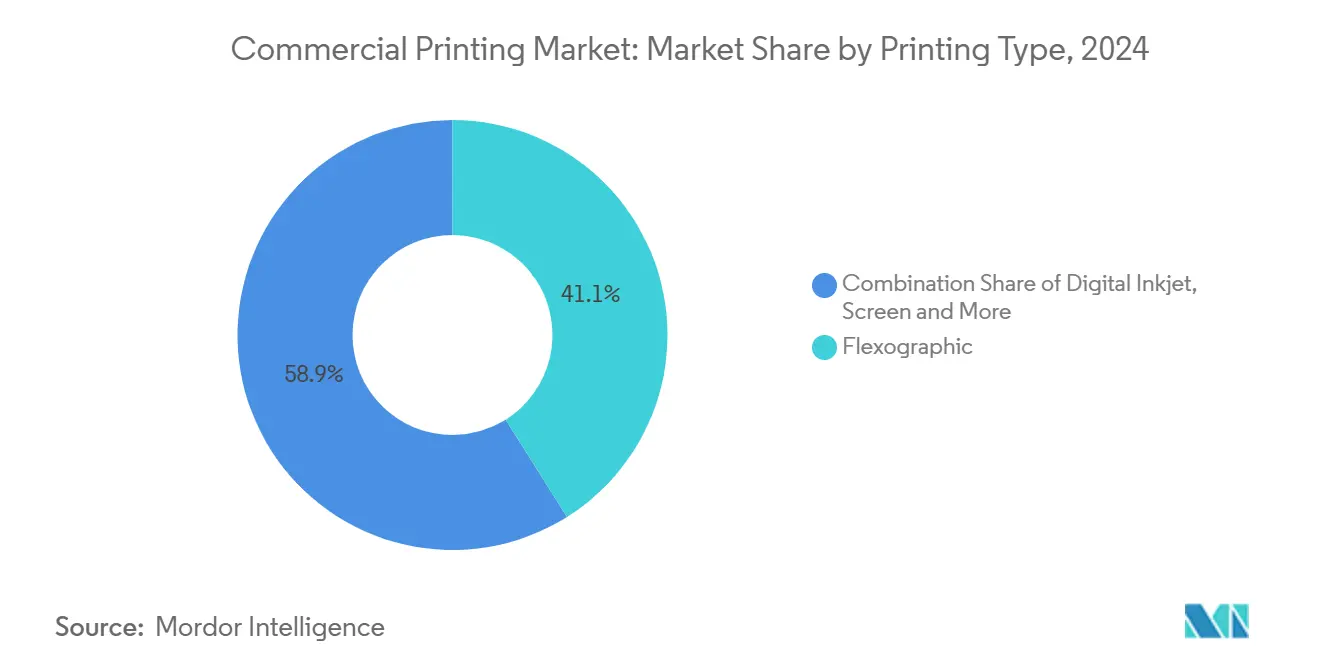
Note: Segment shares of all individual segments available upon report purchase
By Application: Packaging Dominance Reflects Consumer Goods Expansion
Packaging held 44.08% of commercial printing market share in 2024 and will rise at a 3.07% CAGR on the back of e-commerce parcel volumes and brand premiumization. Folding cartons and flexible pouches serve cosmetics, nutraceuticals, and ready-to-eat meals, sectors that rely on vivid shelf appeal. Publishing work—newspapers, magazines, softcover books—experiences ongoing volume erosion, especially in North America and Western Europe. Yet manga and small-batch literary titles printed on recycled paper are registering niche growth among environmentally conscious consumers.
Commercial printing industry vendors diversify by offering “campaign kits” that bundle corrugated shipper boxes, point-of-sale displays, and personalized insert cards. Printed electronics embedded in packages enable temperature monitoring and anti-counterfeiting, features valued by pharmaceutical and luxury brands in Asia-Pacific. Packaging’s resilience gives printers an anchor revenue stream, offsetting cyclical ad-spend patterns in other segments.
By Print Material: Sustainability Drives Substrate Innovation
Paper and cardboard accounted for 68.32% of 2024 revenue, favored for recyclability and cost efficiency. Plastic-based films, while only a minority today, will outpace fiber substrates with a 4.01% CAGR as they gain share in outdoor-exposed labels and aseptic food packs. The commercial printing market size for bio-coated papers able to resist oil, grease, and moisture is expanding swiftly; these grades allow brand owners to drop plastic lamination, facilitating single-stream paper recycling.
Two Sides North America confirms that bio-coated boards now meet ASTM D6400 compostability norms, opening doors for quick-service restaurant clamshells and fruit trays..[3]Two Sides North America, “Compostability of Bio-Coated Paper,” twosidesna.org Concurrently, experiments in marine-safe films produced from algae feedstock promise barrier performance with minimal petrochemical content, although commercial scale remains limited. Material suppliers target offset and flexo presses first, then adapt chemistries for inkjet as head compatibility improves.
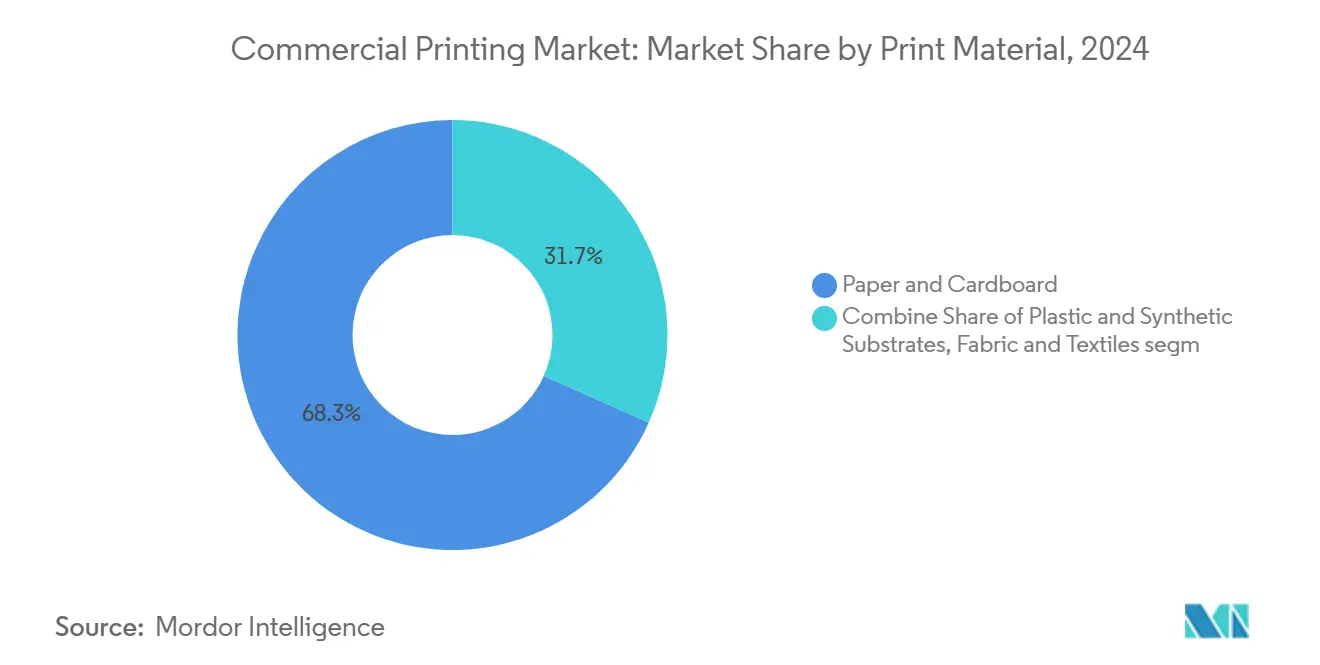
Note: Segment shares of all individual segments available upon report purchase
By Format: Direct-to-Object Printing Emerges as Growth Leader
Small-format sheets—business cards, flyers, and small cartons—still represented 58.45% of 2024 turnover. Yet direct-to-object units, printing directly on drinkware, electronics, and medical devices, will grow at a 5.21% CAGR. Higher profit per square meter and minimal inventory overheads attract converters keen to hedge against commoditized litho runs. The commercial printing market size for direct-to-object platforms is forecast to double by 2030 as improved UV-LED pinning units widen substrate latitude.
OEMs integrate tactile varnish and laser texturing stations inline, enabling mass customization for short-lead corporate gifts. Mid-western U.S. service bureaus report that corporate procurement teams are willing to pay a 25% price premium for personalized stainless tumblers delivered in under one week, compensating for lower volumes in standard screen-printed promotional lines.
Geography Analysis
Asia-Pacific dominated revenue with 45.64% in 2024 and is projected to post a 3.28% CAGR through 2030 as consumer packaged goods output, domestic e-commerce volumes, and government stimulus for infrastructure projects expand print demand. China alone adds hundreds of corrugated converting lines annually, while India’s label sector benefits from GST roll-out mandating standardized barcode identification across logistics channels. Regional brands actively specify QR-code smart packaging to build loyalty among mobile-first consumers.
North America maintains a sizeable slice of global output, although growth is modest. The commercial printing market size in the United States is steady as demand migrates toward data-driven direct mail, pharmaceutical inserts, and luxury packaging. Canada’s printers focus on short-run book production fueled by educational publishing mandates favoring domestically printed content.
Europe shows flat volume in general commercial work but accelerating investment in C2C recyclable substrates and vegetable-oil inks. Germany is piloting deposit-return systems for paper-based coffee cups, spurring converters to test barrier-coated boards certified for compostability. EU regulations on single-use plastic pack formats will likely channel incremental volume to fiberboard over the medium term.
Latin America and the Middle East & Africa together account for a smaller proportion of the commercial printing market but represent meaningful upside. Brazil’s PET recycling rate reached 56.4% in 2025, allowing food brands to switch to PCR-rich labels and flexible pouches, which in turn creates print volume.[4]MDPI, “Post-Consumer Recycled PET in Brazilian Food Packaging,” mdpi.com Gulf Cooperation Council states are building new industrial zones that house packaging plants serving dairy, beverage, and personal-care clusters, underpinning near-term demand for offset and gravure equipment.
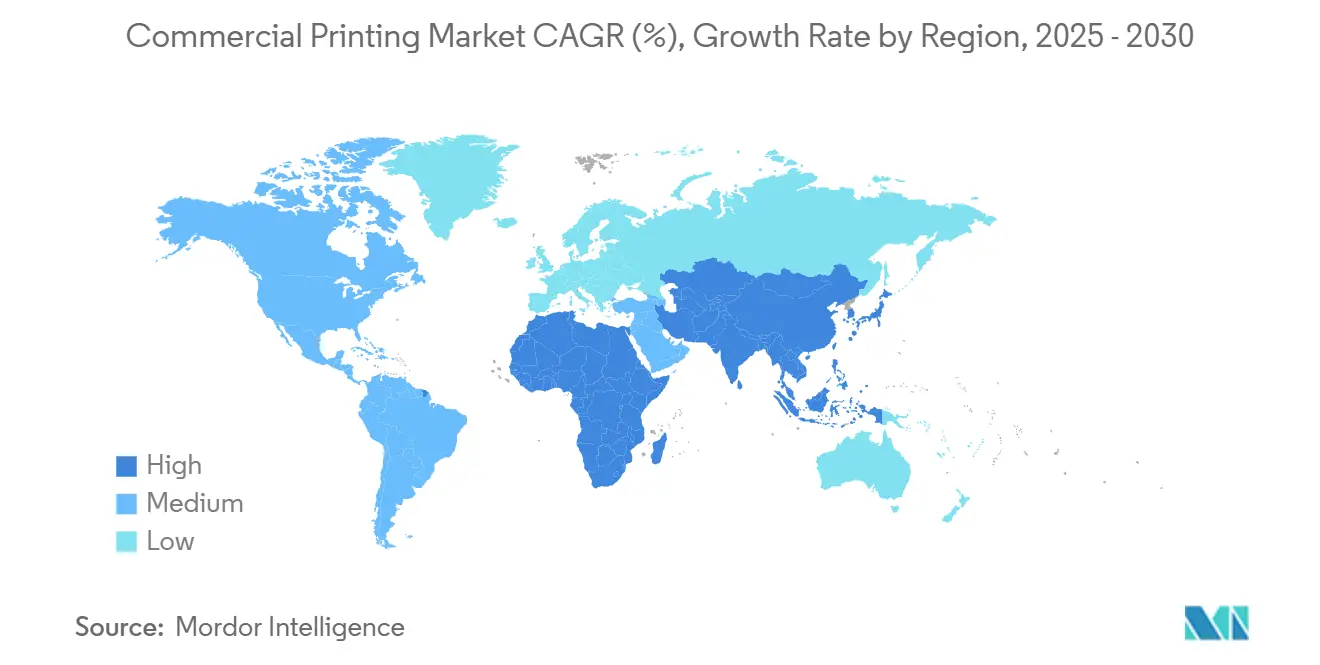
Competitive Landscape
The market remains moderately fragmented. Toppan Inc., Dai Nippon Printing, and R.R. Donnelley retain scale leadership in high-volume packaging, security documents, and transactional mail. Regional groups in China, India, and Southeast Asia specialize in flexible pouches and short-run digital labels for local FMCG suppliers. Cross-border M&A is rising: several European converters have acquired Midwest U.S. digital shops to re-shore critical capacity and leverage favorable exchange rates.
Technology partnerships feature prominently. In 2025, Dai Nippon Printing linked its cloud analytics platform with leading MIS vendors, giving enterprise customers real-time KPI dashboards for job status and carbon footprint. Similar alliances between press builders and substrate innovators are accelerating trials of mono-material paper structures that run on standard folder-gluers.
Sustainability differentiates competitors. Toppan’s plant-based barrier film “GL-FILM ECO” is replacing conventional PVDC layers in medical blister packs, offering recyclability without sacrificing moisture protection. R.R. Donnelley has rolled out a network of on-demand print hubs within 50 miles of the top 20 U.S. metropolitan areas, lowering transit emissions and turnaround times for retail signage. Meanwhile, fast-growing disruptors in Europe provide subscription-based “carbon-balanced” print services, bundling life-cycle assessments with each order to meet corporate ESG targets.
Commercial Printing Industry Leaders
-
ACME Printing
-
Cenveo Worldwide Limited
-
R.R. Donnelley & Sons Company
-
Vistaprint (CIMPRESS PLC)
-
Toppan Inc.
- *Disclaimer: Major Players sorted in no particular order
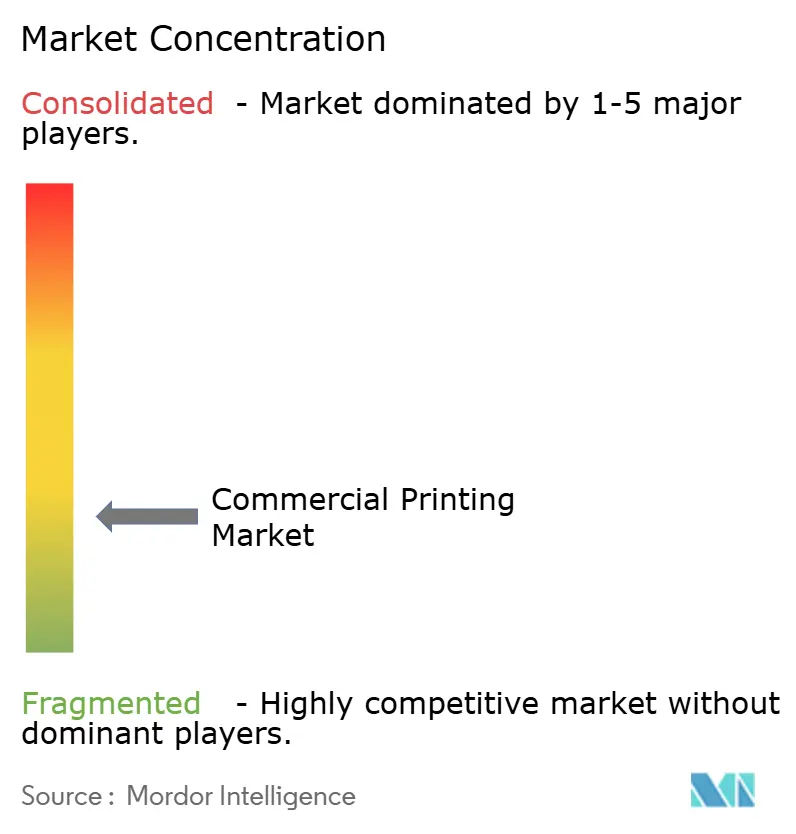
Recent Industry Developments
- June 2025: RRD began a USD multi-million digital upgrade of its Austell, GA plant, installing an HP Indigo 120K Digital Press, a PageWide Advantage 2200 line and the site’s first fully robotic material-handling system to accelerate variable print-on-demand services.
- April 2025: TOPPAN Holdings completed its purchase of Sonoco’s thermoformed and flexible-packaging unit, adding 22 factories and roughly 4,500 staff to scale sustainable packaging and related commercial-printing services across the Americas.
- December 2024: Heidelberg and Canon formalized a global partnership to co-market Canon’s sheet-fed inkjet engines alongside Heidelberg offset lines, enabling hybrid workflows for medium-volume commercial printing.
- May 2024: Heidelberg introduced the Jetfire 50 and Jetfire 75 sheet-fed inkjet presses, broadening its portfolio with B2-format, water-based systems aimed at short-run packaging and direct-mail work.
Research Methodology Framework and Report Scope
Market Definitions and Key Coverage
Our study defines the commercial printing market as the revenue generated from factory-scale production of printed materials, packaging, advertising collateral, transactional documents, books, periodicals, and other communication pieces produced with offset, digital inkjet, flexographic, screen, gravure, and allied processes. Values are reported in USD at manufacturer gate.
Scope exclusion: Home/office desktop printers and purely digital fulfillment services that never produce a physical print are outside the remit of this study.
Segmentation Overview
- By Printing Type
- Offset Lithography
- Digital Inkjet
- Flexographic
- Screen
- Gravure
- Other Printing Types
- By Application
- Packaging
- Advertising
- Publishing
- Books
- Magazines
- Newspapers
- Other Publishing
- Corporate and Transactional Printing
- Other Application
- By Print Material
- Paper and Cardboard
- Plastic and Synthetic Substrates
- Fabric and Textiles
- Metal and Foils
- Other Materials
- By Format
- Large-Format Printing
- Small-Format Printing
- Direct-to-Object Printing
- By Geography (Value)
- North America
- United States
- Canada
- Mexico
- Europe
- Germany
- United Kingdom
- France
- Italy
- Spain
- Russia
- Rest of Europe
- Asia-Pacific
- China
- Japan
- India
- South Korea
- Australia and New Zealand
- Rest of Asia-Pacific
- Middle East and Africa
- Middle East
- Saudi Arabia
- United Arab Emirates
- Turkey
- Rest of Middle East
- Africa
- South Africa
- Nigeria
- Kenya
- Rest of Africa
- Middle East
- South America
- Brazil
- Argentina
- Rest of South America
- North America
Detailed Research Methodology and Data Validation
Primary Research
We interviewed plant managers, equipment vendors, label converters, and print-buying brand teams across Asia-Pacific, North America, and Europe. Conversations clarified average run lengths, real-world price erosion on digital jobs, and regional capacity utilization, allowing us to stress-test assumptions derived from secondary data.
Desk Research
Mordor analysts begin with publicly accessible datasets such as United States Bureau of Labor Statistics output indexes, Eurostat Structural Business Statistics, UN Comtrade trade codes for printed matter, and industry association insights from bodies such as Printing Industries of America and Intergraf. These are supplemented with corporate filings, investor decks, and curated news from Dow Jones Factiva. Questel patent analytics adds visibility on technology adoption cycles. The list above is illustrative; many additional sources underpin our desk work.
Market-Sizing & Forecasting
A top-down build starts with national production and trade data, reconstructed into a demand pool and then aligned with application mix. Results are corroborated through selective bottom-up checks, sampled average selling price multiplied by estimated impressions for key formats, to refine totals. Key variables tracked include packaging print tonnage, digital press install base, ad-spend share shifting to print, average square-meter yields, unit ink consumption, and regional wage indices. Multivariate regression paints relationships between those drivers and revenue, while scenario analysis adjusts for macro and substrate cost shifts. Data gaps in supplier roll-ups are bridged using triangulated ranges agreed in expert calls.
Data Validation & Update Cycle
Outputs pass successive anomaly screens, peer review, and senior analyst sign-off. We revisit models quarterly when raw-material shocks or capacity additions breach preset variance bands; otherwise, full refreshes occur annually and each client download triggers a final currency and news check.
Why Mordor's Commercial Printing Industry Size and Share Research with Trends and Analysis (Segments, Regions) Baseline Deserves Trust
Published numbers often diverge because firms choose dissimilar scopes, pricing ladders, and update cadences. By anchoring estimates to verifiable production data and validating run-rate assumptions through field interviews, Mordor delivers a midpoint that decision-makers can rely on.
Benchmark comparison
| Market Size | Anonymized source | Primary gap driver |
|---|---|---|
| USD 837.2 B (2025) | Mordor Intelligence | - |
| USD 736.3 B (2025) | Global Consultancy A | Excludes direct-to-object and security printing; relies on linear trend extension |
| USD 412.2 B (2025) | Trade Journal B | Captures only independent print shops, omits in-house presses and value-added services |
These comparisons show that scope breadth and validation depth materially influence market value. By combining transparent data sources with continuous expert feedback, Mordor Intelligence offers a balanced, repeatable baseline that minimizes surprises for strategists and investors.
Key Questions Answered in the Report
What is the current size of the commercial printing market?
The commercial printing market is valued at USD 837.20 billion in 2025.
How fast is the commercial printing market expected to grow?
It is projected to post a 2.38% CAGR, reaching USD 940.54 billion by 2030.
Which printing technology is growing the quickest?
Digital inkjet solutions are forecast to expand at a 3.45% CAGR through 2030.
Why does packaging dominate commercial printing demand?
E-commerce expansion and premium brand positioning drive continuous growth in printed packaging, which captured 44.08% revenue in 2024.
How are sustainability trends affecting print substrates?
Printers are shifting to bio-coated paper and vegetable-based inks to meet strict VOC limits and consumer demand for recyclable or compostable packaging.
What regions hold the strongest growth prospects?
Asia-Pacific leads with a 45.64% revenue share and a 3.28% CAGR, supported by manufacturing expansion and rising consumer spending.
Page last updated on:
